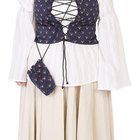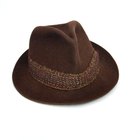
When it comes to cloaks and capes, the differences between the two may seem confusing or even nonexistent. Both are made from one sheet of fabric and worn draped over the shoulders, without sleeves. It also doesn’t help that people often use the two words interchangeably. However, cloaks and capes are definitely distinct. The major differences are length, style and function.
Length Differences
One of the easiest ways to distinguish a cape from a cloak is by looking at the lengths. In general, capes are much shorter than cloaks. The length of a cape is usually anywhere from the top of the torso to the hips. Rarely will a cape fall past the thighs. On the other hand, the shortest cloak falls below the knees. Many cloaks are calf-length at minimum, and some are floor-length.
Style Differences
Besides the difference in length, cloaks and capes have aesthetic details that separate one from the other. Capes generally cover the back and are open and loose in the front. They usually fasten around the neck with a tiny hook or cords that tie together, but it is becoming more common to see capes with button or zipper closures down the front. Capes generally come in a more colorful, embellished selection of styles than cloaks, and because of this capes are usually worn as a fashion statement. Some capes even come with a belt looped through them, creating the look of a cinched waist and billowing sleeves.
Cloaks cover your front and back. They are more streamlined, fitted and tailored than capes. Because of the tailoring, in the 1920s and '30s women sometimes wore cloaks as completed looks styled like a dress, adorned with belts, gloves and jewelry. This is rarely done today, but cloaks are still dressier than capes and are often worn to evening events over gowns.
Functional Differences
Historically, cloaks have served more of a functional purpose than capes. From the 1500s to 1800s, cloaks provided warmth but were also used to signify a person’s social rank or occupation. Today, cloaks are used to protect the wearer from the elements. You are more likely to find a hood on a cloak than a cape, though it’s still possible to find a cape with one and a cloak without one. Capes may have a collar for added warmth, but some don’t even have that. A cape’s main function is to cover the back of the wearer for warmth. Since a cape is much shorter than a cloak, slit openings for the arms are not always necessary because your arms can come through the bottom opening of the cape. A cloak usually has slit openings for the arms since its length requires it. Since the '50s, cloaks have lost popularity to coats. Capes also fell into the fashion bin at the same time, but they made a stylish comeback in the first decade of the 21st century.
Making It Your Own
If you would like to call one (or both) of these garments your own, search major department stores for a trendy cape; for cloaks, brick-and-mortar and online thrift or vintage stores usually have a nice selection.
Related Articles

Parka vs Bomber Jacket

Difference Between Bodice and Corset

What Is the Difference Between a ...

Different Kinds of Blouses

Sleeve Styles for Fat Arms

The Best Formal Dress Style for Pear ...

Types of Plaids

Shawl Collar Vs. Lapel Tuxedo

Blouses to Wear Under a Suit Jacket

Could a Black Suit Be Worn Instead of a ...

Brooch Vs. Pin

How Long Should a Sport Coat Be?

What Do Chinese Women Wear?

How to Dress for a Gala for Men

How to Make a Men's Kimono

Sheath vs. Shift Dresses

What Do Women Pirates Wear?

Difference in Misses, Juniors, and ...

1950s Gangster Clothes

Types of Men's Vests
References
Resources
Writer Bio
Atembe Giles has written for multiple publications over the past six years, including digital publications such as College Fashionista and publications such as Campus Fashion Today, Kaleidoscope Magazine and Black Ink.
Photo Credits
Victor Boyko/Getty Images Entertainment/Getty Images